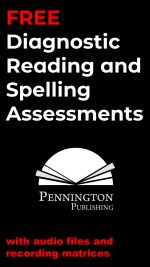Level Books with Word Recognition
As a teacher-publisher, I write articles such as this to inform, advocate, cajole, and sell my English-language arts and reading intervention programs to teachers. I’ve been doing so for quite awhile and have written over 700 articles. Of these articles, one is near the top in popularity and is certainly the most controversial: The 18 Reasons Not to Use Accelerated Reader. When I wrote the article, I had recently transitioned back into the classroom (middle school ELA) from my position as a district reading specialist.
The site level reading specialist provided a pre-service day staff development in which she mentioned AR as our schoolwide reading program. She stressed the importance of using leveled books to match the reading levels of our students. She demonstrated how the AR program did just that. I chose to ignore the remark and put off scheduling my classes for their AR testing in the computer lab. When I got the final “you have to” mandate, I decided to provide a list of reasons why I would not be using Accelerated Reader as my reading program. So much for being a team-player. To her credit, the site level reading specialist did not snitch on me to the principal, or if she did I never knew it.
I decided to post what I had written on my blog.
Wow. The reader response was immediate and contentious. Teachers, parents, and students contributed to the discussion. Parents and students provided cogent comments and examples of “AR abuse” from their own experiences. But, it has been the teacher-response that has both baffled and informed my subsequent writing.
As a publisher, my audience is primarily teachers. Parents and students are not huge markets for my reading intervention program 🙂 Teachers have taken this article criticizing AR quite personally. Although many have been supportive of the points I made in the article; other teachers have perceived my comments as being negative judgments upon their professional expertise. The only comments I have trashed have been those filled with expletives or those which would embarrass teachers the next day after posting a response following one too many glasses of wine.
One such response came this morning regarding book levels. The teacher claimed that in my article I advocate dumping all means of matching the levels of books to the reading levels of students. What?
In re-reading my article, I don’t see that at all. Secondly, I want to be clear that I do support a common sense approach to leveling books to match the reading levels of readers.
Two approaches to how to level books and match them to readers are in general practice today:
- Quantitative Measures: Lexiles, the DRA, F&P/GRL, and even the ATOS (AR testing). My Take? The quantitative measurements are cumbersome to apply to books and developing readers. So many factors go into the levels of books. Although authors certainly consider these factors (their publishers require them to do so) in writing and editing their books, the variables are endless: subject matter, prior knowledge, cultural context, etc. Additionally, the reader’s Lexile range (or other measures) is quite a limited measure (syllables, sentence length, syntax, etc.) and does not factor in maturity, prior knowledge, motivation, etc.
- Qualitative Measures: On the other side of the reading philosophical spectrum, I would argue that a Lucy Calkin or guided reading re-tell is subject to just as many arbitrary judgments as the quantitative measures and is time-consuming, to say the least.
The first problem with both approaches is that they are teacher-dependent. They essentially leave parents and the readers themselves (the students) out of the book selection process. The second problem is that both methods over-reach. Selecting a book to match the reading level of a reader is just as much art as it is science. And, it’s not that big of a deal which level a reader reads (with some common sense limitations). Thirdly, the pre-determined levels of books should not be straitjackets for readers.
A Quick and Simple Approach to Book Selection
Much better to affirm parental judgment in terms of which books are challenging for their own children. Even much better to equip students with self-selection of books with simple word recognition techniques. As a reading specialist, I still buy in to the useful categorizations of independent (98%), instructional (90–97%), and frustrational (less than 90%) levels of word recognition. Call me simplistic, but it’s the words they know and the ones they don’t which should be the primary means of book selection.
The old “five finger” for primary and intermediate elementary and “ten finger” for upper elementary and secondary readers works much better and is far more simple to use as a book selection guide than the tests and re-tells levels. Each finger represents a word on the page which the student could not adequately define by meaning, example, etc. Too few fingers, too easy; too many fingers, too hard. Simple, but effective. Parents can easily assess and train their children to apply the same guidelines to selecting their own books. My own experience using this technique is that the finger counting is equivalent to about 5% unknown words. Perfect for independent reading with just a bit of instructional level vocabulary thrown in to help grow a reader’s word knowledge. Additionally, I’ve found that this method highly correlates with the quantitative level assessments and weeds out some of the inaccuracies of those tests. The difference in terms of selecting books is minimal.
Plus, let’s not forget a dose of good old-fashioned common sense and the role of motivation for a developing reader. If the kid is interested (as long as the book has some challenging vocabulary), even though a random page is 17 fingers for the reader, let the child select it. A personal anecdote may help: My slightly above grade-level fourth grader, Kenny, was dying to read the last Harry Potter novel, Harry Potter and the Deathly Hallows, when it first came out. Clearly, the quantitative measures ATOS 6.9 (34 AR points), Lexile 880, DRA, F&P/GRL Z, GLE 7.4 should have prevented his MA reading specialist father (me) from purchasing this “frustration level” book. However, I ignored the quantitative data and waited in line for the midnight release of this treasured book. Kenny plowed through the book and enjoyed it immensely. By the end of fourth grade, Kenny was significantly above grade level and a confident reader. Thanks to his teacher and J.K. Rowling. Conversely, if the book is only five fingers for a middle school student, let her read it if she wants to, with a promise to read a more challenging book the next time. The easier word recognition book will provide its own benefits.
*****

The Science of Reading Intervention Program
The Science of Reading Intervention Program: Word Recognition includes explicit, scripted, sounds to print instruction and practice with the 5 Daily Google Slide Activities every grades 4-adult reading intervention student needs: 1. Phonemic Awareness and Morphology 2. Blending, Segmenting, and Spelling 3. Sounds and Spellings (including handwriting) 4. Heart Words Practice 5. Sam and Friends Phonics Books (decodables). Plus, digital and printable sound wall cards, speech articulation songs, sounds to print games, and morphology walls. Print versions are available for all activities. First Half of the Year Program (55 minutes-per-day, 18 weeks)
The Science of Reading Intervention Program: Language Comprehension resources are designed for students who have completed the word recognition program or have demonstrated basic mastery of the alphabetic code and can read with some degree of fluency. The program features the 5 Weekly Language Comprehension Activities: 1. Background Knowledge Mentor Texts 2. Academic Language, Greek and Latin Morphology, Figures of Speech, Connotations, Multiple Meaning Words 3. Syntax in Reading 4. Reading Comprehension Strategies 5. Literacy Knowledge (Narrative and Expository). Second Half of the Year Program (30 minutes-per-day, 18 weeks)
The Science of Reading Intervention Program: Assessment-based Instruction provides diagnostically-based “second chance” instructional resources. The program includes 13 comprehensive assessments and matching instructional resources to fill in the yet-to-be-mastered gaps in phonemic awareness, alphabetic awareness, phonics, fluency (with YouTube modeled readings), Heart Words and Phonics Games, spelling patterns, grammar, usage, and mechanics, syllabication and morphology, executive function shills. Second Half of the Year Program (25 minutes-per-day, 18 weeks)
The Science of Reading Intervention Program BUNDLE includes all 3 program components for the comprehensive, state-of-the-art (and science) grades 4-adult full-year program. Scripted, easy-to-teach, no prep, no need for time-consuming (albeit valuable) LETRS training or O-G certification… Learn as you teach and get results NOW for your students. Print to speech with plenty of speech to print instructional components.
Click the SCIENCE OF READING INTERVENTION PROGRAM RESOURCES for detailed program description, sample lessons, and video overviews. Click the links to get these ready-to-use resources, developed by a teacher (Mark Pennington, MA reading specialist) for teachers and their students.
Get the SCRIP Comprehension Cues FREE Resource:
![]()
Get the Diagnostic ELA and Reading Assessments FREE Resource:![]()
*****
Literacy Centers, Reading, Spelling/Vocabulary, Study Skills












